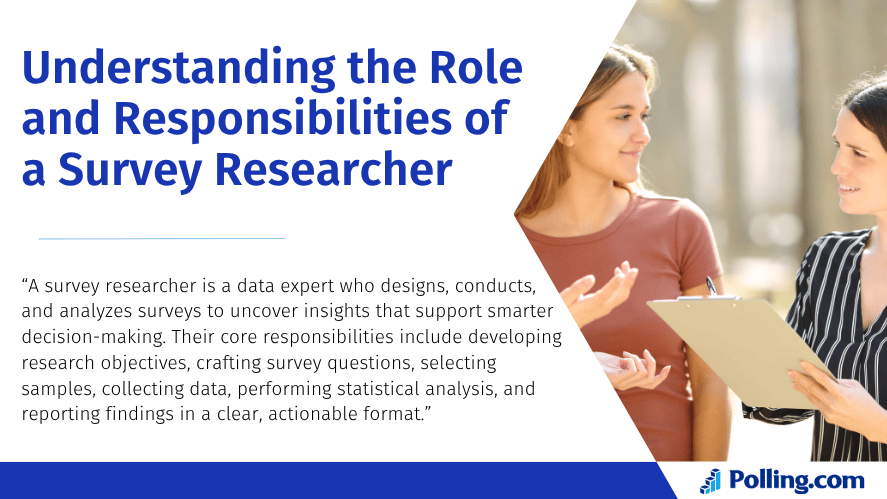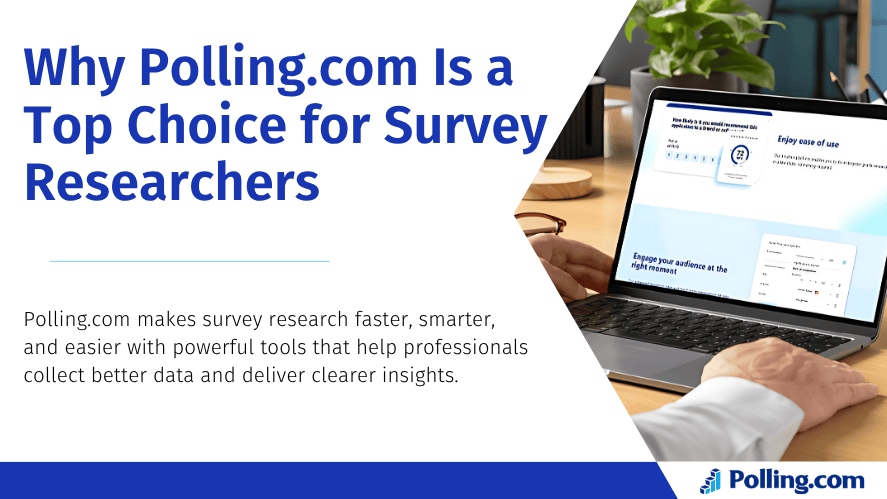
Survey Researcher: How They Drive Strategic Business Decisions
A survey researcher helps organizations make smarter decisions by collecting and analyzing data. Their job is to design surveys, gather responses, and turn the results into clear, useful insights. Businesses use their findings to shape products and marketing. Governments rely on them to understand public opinion. Even customer service teams use surveys to improve how they support people.
Whether it’s a market research survey, a customer feedback form, or a political poll, survey researchers turn questions into answers. With tools like Polling.com, they can do their work faster, more accurately, and at a larger scale.
So how do survey researchers make such a big impact? And what makes Polling.com a tool of choice for professionals? Let’s explore how survey research supports better decisions and why it matters more than ever.
What Is a Survey Researcher?

A survey researcher is someone who gathers and studies people’s opinions using surveys. These professionals ask the right questions to the right people in order to learn how a group thinks, behaves, or feels about a topic.
Their job is more than just sending out a form. It includes:
- Understanding the problem that the survey needs to solve
- Writing clear, unbiased questions
- Choosing the best format (multiple choice, rating scales, open-ended)
- Using the right tools to send out the survey and collect answers
- Analyzing data to spot trends, differences, and useful insights
- Presenting findings through reports, graphs, or presentations
For example, if a clothing brand wants to find out why sales are dropping, a survey researcher could create a short customer research survey asking shoppers about pricing, quality, and style preferences. The results may show that customers love the quality but want more colors or better sizing.
This kind of feedback is what helps businesses change course and stay competitive.
How Survey Researchers Help Organizations Make Smarter Decisions

Most businesses today talk about being “data-driven,” but not all know how to gather or use that data. This is where a survey researcher makes a big difference.
By planning and running structured surveys, they help organizations:
- Validate new product ideas before investing heavily
- Test marketing messages to find the most effective ones
- Segment customer groups for personalized experiences
- Track brand reputation over time
Let’s say a company wants to enter a new market overseas. Before launching, a market research survey can help them understand cultural preferences, buying behavior, and price sensitivity. Without this data, they risk failure due to poor targeting.
In this way, survey research reduces risks and guides smarter decisions. It’s not just helpful it’s essential.
Enhancing Customer Experience Through Data
In today’s competitive market, customer satisfaction has become one of the biggest focus areas for modern companies. Even so, a single bad experience can quickly lead to negative reviews, lost sales, and a damaged brand reputation.
Survey researchers help stop that from happening.
By designing smart, well-timed customer research surveys, they collect feedback that might otherwise go unnoticed. These surveys can be used:
- Right after a purchase
- After customer support interactions
- During product onboarding
- As part of regular loyalty check-ins
The data collected helps customer experience (CX) teams understand what’s working and what’s not. For example, if 60% of customers say they had trouble checking out online, the business knows exactly where to focus.
Instead of making guesses, businesses use survey results to take real, customer-driven action.
Informing Political and Social Policy
Beyond the business world, survey researchers play a key role in shaping our society.
Governments, nonprofits, and social organizations use research surveys to:
- Study public opinion about healthcare, education, and safety
- Measure the impact of new policies or laws
- Identify needs in underserved communities
- Track voter behavior or political leanings
During election years, for example, political campaigns rely on daily or weekly surveys to understand what issues matter most to voters. They adjust their speeches, ads, and platforms based on what survey researchers uncover.
Even during emergencies like a pandemic or natural disaster fast, accurate surveys help leaders understand what people need and how they’re coping.
Tools Survey Researchers Use Today
Why Polling.com Is a Top Choice for Survey Researchers

For any survey researcher, the right tools can make or break a project. Polling.com stands out because it’s designed with research professionals in mind.
Here’s what makes it ideal:
- User-friendly drag-and-drop builder: You can create surveys in minutes without coding.
- Built-in logic: Skip logic and branching help personalize the survey experience.
- Branded templates: Customize designs with logos, fonts, and company colors.
- Real-time analytics: See who’s responding and how in real time.
- Survey scheduling: Launch surveys automatically at the right time.
Whether it’s a market research survey, a government poll, or a customer feedback form, Polling.com helps survey researchers work smarter not harder.
Comparison with Other Popular Tools
Here’s how Polling.com compares to others:
| Feature | Polling.com | SurveyMonkey | Google Forms | Typeform |
|---|---|---|---|---|
| Templates | Yes, many options | Some | Very few | Some, modern look |
| Analytics | Real-time, deep | Good | Basic | Moderate |
| Customization | High | Medium | Low | High |
| User-friendliness | Very easy | Easy | Very easy | Moderate |
| Best For | Professionals | General use | Simple surveys | Stylish forms |
All these tools have their place, but Polling.com is built with serious survey research in mind.
Automation, Sampling Tools, and Data Visualization Features
Because survey researchers often work with tight deadlines, manual processes can become a major hurdle. As a result, automation is now a must-have in their workflow.
Polling.com includes:
- Sampling tools that help choose respondents based on location, age, gender, or preferences
- Automated invitations and follow-ups to boost response rates
- Custom dashboards that turn raw data into visual charts and reports instantly
- Export features to download results into Excel, PDF, or dashboards
These features not only save time but also improve accuracy and clarity, making it easier to share insights with managers or clients.
The Process a Survey Researcher Follows
Designing the Survey Instrument
At the planning stage of a survey, most of the critical thinking takes place. Rather than jumping in with random questions, survey researchers follow a thoughtful process. Specifically, they:
- Define the goal: What do we want to know?
- Choose the survey type: Online, phone, paper, or face-to-face?
- Write questions: Avoid bias, ask one thing at a time, use plain language
- Test the survey: Run a small pilot survey to find and fix problems
For instance, if you’re doing a market research survey, your questions might include:
- “How often do you purchase this type of product?”
- “What factors are most important to you when choosing a brand?”
- “Would you recommend this product to a friend?”
Each question must serve a purpose. If it doesn’t, it shouldn’t be included.
Sampling and Data Collection
Once the survey is ready, it’s time to pick your audience. This step is called sampling.
Reliable survey results begin with selecting the right sample group. Otherwise, you risk hearing only from people who don’t truly represent your full target group.
For example, if you’re studying teenagers’ social media use but only survey people aged 30+, the data won’t help much.
With smart sampling tools like those in Polling.com, you can target:
- Specific age groups
- Geographic regions
- Gender identities
- Interests or behaviors
This precision helps ensure you collect relevant, high-quality data that matches your goals.
Analyzing and Reporting Results
Once responses start coming in, the real work truly begins. Instead of only looking at totals, survey researchers dig deeper to uncover insights hidden within the data.
They look for:
- Patterns and trends: Are certain answers common across groups?
- Differences between segments: Do men and women answer differently? What about age groups?
- Key findings: What should the organization change or improve?
To do this efficiently, they rely on software tools to run statistical tests, generate charts, and create summaries. Ultimately, these reports are shared with decision-makers, marketers, product teams, or even the public.
A clear, easy-to-read report means the data gets used not ignored.
Career Path and Opportunities for Survey Researchers

The demand for skilled survey researchers is growing, especially in tech, marketing, healthcare, and public policy. More businesses want to base decisions on data, and surveys are often the fastest way to collect that data.
According to recent industry insights:
- Entry-level researchers earn around $50,000–$60,000
- Mid-level professionals often earn $70,000–$85,000
- Senior survey researchers and managers can earn $100,000+
Many also work as consultants, taking on projects for multiple clients. Others go into teaching, public speaking, or writing research reports.
And since most industries rely on survey research methods, these professionals enjoy career flexibility and strong job security.
Educational Paths and Certifications
Educational requirements typically include:
- Bachelor’s degree (entry-level roles)
- Master’s degree in social sciences or statistics (for advanced positions)
Recommended certifications:
- PRC (Professional Researcher Certification)
- AAPOR (American Association for Public Opinion Research) membership
These credentials enhance credibility and career prospects.
How Businesses Can Benefit from Hiring or Working with a Survey Researcher
Better Decision Making with Data
When businesses are armed with data-driven insights from a survey researcher, they can make more informed strategic decisions. Consequently, this reduces guesswork and better aligns products or services with actual market demands.
Saving Costs by Avoiding Trial-and-Error Approaches
Trial-and-error can be expensive. Conducting a market research survey before launching a product helps companies avoid missteps, saving time and resources.
Increased ROI Through Targeted Insights
When survey results lead to improved marketing, better user experience, or optimized operations, the ROI is significant. Businesses see growth in:
- Conversion rates
- Customer retention
- Brand loyalty
Hiring a survey researcher is not just a cost it’s a smart investment.
Frequently Asked Questions (FAQ)
A bachelor’s degree in statistics, sociology, or marketing is often sufficient for entry-level roles, but a master’s is preferred for leadership or specialized positions.
Yes. With the explosion of data and need for informed decisions, demand for skilled survey researchers is steadily increasing across sectors.
A survey researcher focuses on designing and collecting data through research surveys, while a data analyst often works with pre-existing data to uncover insights. Both roles are complementary.
Absolutely. Even a small customer research survey can help a local business improve services, optimize marketing, or refine product offerings.
Polling.com combines ease of use, robust analytics, customizable templates, and advanced sampling making it ideal for professionals seeking efficiency and accuracy.
Conclusion & Call to Action
A skilled survey researcher is an indispensable asset in today’s data-driven economy. Whether it’s creating a market research survey, improving customer experience, or influencing policy, their insights help leaders make confident, strategic decisions.
Tools like Polling.com elevate survey researchers by providing intuitive platforms, intelligent automation, and comprehensive analytics.
👉 Ready to elevate your research game? Explore our powerful tools or connect with professional survey researchers on Polling.com today.
